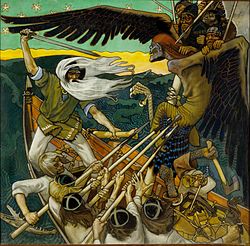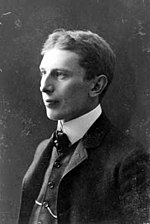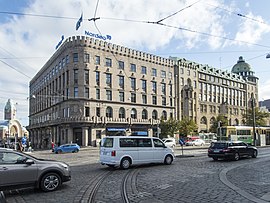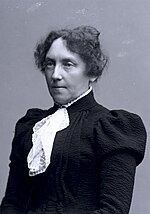Golden Age of Finnish Art



The Golden Age of Finnish Art coincided with the national awakening of Finland, during the era of the Grand Duchy of Finland under the Russian Empire. It is believed to span an era from the late 19th Century to the early 20th Century, approximately 1880 to 1910.[1] The epic poetry form known as Kalevala, developed during the 19th Century, provided the artistic inspiration for numerous themes at the time, including in visual arts, literature, music and architecture;[2] however, the "Golden Age of Finnish Art" is generally regarded as referring to the realist and romantic nationalist painters of the time.[3] Notable figures of the time include Akseli Gallen-Kallela, Pekka Halonen, Albert Edelfelt, Jean Sibelius, Eino Leino, Helene Schjerfbeck, Emil Wikström, Eero Järnefelt and Eliel Saarinen.
Finnish art became more widely known in Europe at the Paris Exposition of 1900, where the Finnish pavilion was one of the most popular among the attendees.[4]
Artists
There were a number of notable visual artists who are considered to have been part of the Golden Age of Finnish Art.
Painters



The following list of painters does not include artists who are sometimes considered to be part of the Golden Age but generally largely predate it; several notable painters, such as Werner Holmberg, exist in this category.[5] Ferdinand von Wright, the notable Finnish artist whose 1886 The Fighting Capercaillies is considered a seminal Finnish painting, is also regarded as predating the Golden Age.[6][7][8] The numerous painters of the Düsseldorf school of painting, such as Berndt Lindholm, Hjalmar Munsterhjelm and Fanny Churberg, may be regarded as Golden Age painters; however, their work is generally associated with an earlier era of artistic development.[9][10][11]
Adolf von Becker, however, is regarded as a significant figure to the Golden Age, resulting from his education and tutelage of numerous artists of the era;[12] in addition, Robert Wilhelm Ekman, as an early and notable painter of Kalevala, laid the foundation for similar following works.[13]
Sculptors



| Artist | Notable work |
|---|---|
 Ville Vallgren (1855–1940) [58][59][60] |
 Havis Amanda, 1908 |
 Emil Wikström (1864–1942) [61][62][63] |
 Lantern Carriers, 1914 |
Architects





| Artist | Notable work |
|---|---|
 Lars Sonck (1870–1956) [64][65][66] |
 Tampere Cathedral, 1907 |
 Wivi Lönn (1872–1966) [67][68][69] |
 Tampere Central Fire Station, 1908 |
 Eliel Saarinen (1873–1950) [70][71][72] |
 Helsinki Central railway station, 1909 |
 Herman Gesellius (1874–1916) [70][73][74] |
 Wuorio House (Unioninkatu 30), 1909–1914 |
 Armas Lindgren (1874–1929) [70][75][76] |
 Mannerheimintie 7, 1914 (also 5 together with Wivi Lönn) |
See also
References
- ^ Salo, Maaria (21 February 2017). "Suomen taiteen kultakausi ja taiteilijan Kultakausi". Kritiikin Uutiset. Retrieved 8 July 2020.
- ^ "Kalevala - Suomen taiteen kultakausi". Suomalaisen Kirjallisuuden Seura. Archived from the original on 2016-03-05. Retrieved 2017-12-10. "Archived copy". Archived from the original on 2016-03-05. Retrieved 2017-12-11.
{{cite web}}: CS1 maint: archived copy as title (link) - ^ "Suomen Taidehistoria". Suomen Virtuaaliammattikorkeakoulu. Archived from the original on 16 July 2020. Retrieved 15 July 2020. "Archived copy". Archived from the original on 16 July 2020. Retrieved 15 July 2020.
{{cite web}}: CS1 maint: archived copy as title (link) - ^ "The Golden Age of Finnish Art". Art Museum of Estonia. Archived from the original on 2017-12-10. Retrieved 2017-12-10. "Archived copy". Archived from the original on 2017-12-10. Retrieved 2017-12-11.
{{cite web}}: CS1 maint: archived copy as title (link) - ^ "Taidehalli esittelee ensi kertaa Fortumin kokoelmaa". Turun Sanomat. 9 October 2007. Archived from the original on 16 July 2020. Retrieved 15 July 2020.
- ^ "von Wrightin veljekset suomalaisen kansallisidentiteetin alkutaipaleella". Bukowskis. 5 December 2017. Retrieved 15 July 2020.
- ^ "Haavoittunut enkeli on suomalaisten suosikkitaulu". Yle. 2 December 2006. Retrieved 23 May 2020.
- ^ Blencowe, Annette (5 February 2013). "Albert Edelfeltin Leikkiviä poikia rannalla äänestettiin Suomen merkittävimmäksi maalaukseksi". Retrieved 22 May 2020.
- ^ "Emil Aaltosen taidekokoelma ja elämäntarina tutuiksi Kimmo Pyykkö -taidemuseon luennolla". STT Info. 13 March 2018. Retrieved 15 July 2020.
- ^ Hakala, Ville (14 January 2018). "Huippunäyttely suomalaisesta taiteesta". Seutuneloset. Retrieved 15 July 2020.
- ^ "Signe ja Ane Gyllenbergin säätiö on jäsen Suomalaisten taidesäätiöiden yhdistyksessä". Gyllenbergs. Archived from the original on 17 July 2020. Retrieved 15 July 2020. "Archived copy". Archived from the original on 17 July 2020. Retrieved 15 July 2020.
{{cite web}}: CS1 maint: archived copy as title (link) - ^ Penttilä, Tiina (2003). Adolf von Becker: Pariisin tien viitoittaja. [Museovirasto]. ISBN 9789525057171. Archived from the original on 2020-07-15.
- ^ "Suomen maalaustaiteen kultakausi". Kookas. Retrieved 15 July 2020.
- ^ Pääkkönen, Sirpa (5 August 2019). "Kultakauden taitavat naiset lumoavassa Halosenniemessä – Naisia tupa täynnä -näyttely jatkuu syyskuulle". Kulttuuritoimitus. Retrieved 15 July 2020.
- ^ Kirves-Torvinen, Virpi (1 December 2014). "Mestareiden näyttely Valamossa". Kirkko ja kaupunki. Retrieved 15 July 2020.
- ^ "Naistaiteilijat kovassa huudossa". Bukowskis. 25 May 2016. Retrieved 15 July 2020.
- ^ Wilska, Liisa (16 December 2012). "Maria Wiikin teos ennätyshintoihin Bukowskilla". Umami. Archived from the original on 15 July 2020. Retrieved 15 July 2020. "Archived copy". Archived from the original on 15 July 2020. Retrieved 15 July 2020.
{{cite web}}: CS1 maint: archived copy as title (link) CS1 maint: bot: original URL status unknown (link) - ^ "Kulje kultakaudelta nykypäivään suomalaisten naistaiteilijoiden matkassa – kokosimme naistenpäivän vinkit klassikoihin ja nykytaiteeseen". Museot. 5 March 2020. Retrieved 15 July 2020.
- ^ "Maria Wiik oli Helene Schjerfbeckin mielestä itseään taitavampi taidemaalari". Yle. 4 January 2020. Retrieved 15 July 2020.
- ^ Stavén, Amanda (22 July 2016). "Albert Edelfelt maalasi kansaa, valoa ja historiaa". Yle. Retrieved 15 July 2020.
- ^ "Albert Edelfelt ja Romanovit, Sinebrychoffin taidemuseo 6.2.–10.5.2020". STT Info. 5 February 2020. Retrieved 15 July 2020.
- ^ Virolainen, Antti (23 April 2020). "Albert Edelfeltin kadonneeksi luullut teokset vihdoin esillä – ISTV kiersi Sinebrychoffin taidemuseon näyttelyn suorassa lähetyksessä". Ilta-Sanomat. Retrieved 15 July 2020.
- ^ "Japanomania-suurnäyttely avaa uuden näkökulman pohjoismaiseen kultakauteen". Amusa. 17 February 2016. Retrieved 15 July 2020.
- ^ Vihanto, Martti (February 2018). "Jäljennös, väärennös ja vuorotellen kumpaakin" (PDF). Abophil. Retrieved 15 July 2020.
- ^ "Serlachiukset – Mäntän medicit". Umami. 24 September 2012. Archived from the original on 15 July 2020. Retrieved 15 July 2020. "Archived copy". Archived from the original on 15 July 2020. Retrieved 15 July 2020.
{{cite web}}: CS1 maint: archived copy as title (link) CS1 maint: bot: original URL status unknown (link) - ^ Kononen, Seppo (26 August 2009). "Eläviä ja kuolleita". Savon Sanomat. Archived from the original on 15 July 2020. Retrieved 15 July 2020.
- ^ "Anna Sahlstén (1859-1931)". Varkaus. Archived from the original on 16 July 2020. Retrieved 15 July 2020.
- ^ Metso, Seppo (19 April 2011). "Caj Bremerin elämäntyö Raumalla". Turun Sanomat. Archived from the original on 15 July 2020. Retrieved 15 July 2020.
- ^ "Kultakauden kermaa Turun taidemuseossa". Keskisuomalainen. 14 December 2010. Retrieved 15 July 2020.
- ^ Marttala, Jorma (10 June 2016). "Kultakauden hippuja Runoilijan tiellä". Ylöjärven Uutiset. Retrieved 15 July 2020.
- ^ Wiljanen, Anna-Maria (10 September 2015). "Suurista taiteen keskuksista periferiaan – sosiaaliset verkostot, taiteilijoiden liikkuvuus ja paikka-myytti taitelijasiirtokuntien kontekstissa. Tapaus Önningeby". Ennen ja nyt. Archived from the original on 16 July 2020. Retrieved 15 July 2020.
- ^ Kuvaja, Sini (18 February 2017). "Tunnetko tämän taiteen kultakauden mestarin Noormarkusta? Aikansa kapinallinen eli ja maalasi rohkeasti". Satakunnan Kansa. Archived from the original on 15 July 2020. Retrieved 15 July 2020.
- ^ "Suomen kultakausi esittäytyy Tukholmassa". Finland Abroad. 20 November 2009. Retrieved 15 July 2020.
- ^ Halonen, Kaisa (8 March 2017). "Kultakauden naistaiteilijat eivät kaunistelleet arkea". Kirkko ja kaupunki. Retrieved 15 July 2020.
- ^ a b c Virolainen, Antti (8 May 2020). "Suomen taiteen kultakauden rakastetuimmat klassikot esillä Ateneumissa – tallenne suorasta lähetyksestä katsottavissa myöhemmin". Ilta-Sanomat. Retrieved 15 July 2020.
- ^ Toivakka, Sari (1 February 2017). "Tätä suomalaista teosta jonotetaan katsomaan National Galleryssa". Savon Sanomat. Retrieved 15 July 2020.
- ^ Suni, Kari (1 September 2017). "Kansallinen taideaarre Raumalle, Schjerfbeckin Toipilas juhlakiertueella". Satakunnan Kansa. Archived from the original on 15 July 2020. Retrieved 15 July 2020.
- ^ Pääkkönen, Sirpa (12 August 2019). "Järnefelt ja Soldan-Brofeldt Viroon: Järvenpään taidemuseo vie Tallinnaan Suomen kultakauden klassikot". Kulttuuritoimitus. Retrieved 20 August 2020.
- ^ "Sinnikkäät ruusut Kultakauden unohtuneet naismestarit saavat arvonsa sata vuotta myöhässä". Helsingin Sanomat. 30 July 1994. Retrieved 20 August 2020.
- ^ Laitinen-Littorin, Pauliina (10 April 2015). "Venny Soldan-Brofeldt oli tuottoisa taiteilija". Taloustaito. Retrieved 20 August 2020.
- ^ Rönkkö, Jaakko (24 January 2013). "Kultakauden intiimi mestari". Savon Sanomat. Retrieved 15 July 2020.
- ^ "Eero Järnefelt: Kaski, 1893". Ateneum. 11 January 2017. Archived from the original on 28 September 2020. Retrieved 15 July 2020. "Archived copy". Archived from the original on 28 September 2020. Retrieved 15 July 2020.
{{cite web}}: CS1 maint: archived copy as title (link) - ^ Peltola, Satu-Lotta (24 January 2013). "Eero Järnefelt isänmaan asialla". Yle. Retrieved 15 July 2020.
- ^ Salo, Maaria (21 February 2017). "Marita Liulia, Lampedusa, 2015 Suomen taiteen kultakausi ja taiteilijan Kultakausi". Kritiikin Uutiset. Retrieved 15 July 2020.
- ^ a b c Salminen, Kari (14 May 2019). "Salaperäiset symbolit". Iltalehti. Retrieved 15 July 2020.
- ^ "Pekka Halonen". Ateneum. 2008. Retrieved 15 July 2020.
- ^ Ruohonen, Johanna (9 July 2008). "Pekka Halonen - kansanmies ja luonnonmystikko". Turun Sanomat. Archived from the original on 17 July 2020. Retrieved 15 July 2020.
- ^ Parkkinen, Pia (21 January 2015). "Ellen Thesleff uudistui viimeiseen saakka". Turun Sanomat. Archived from the original on 15 July 2020. Retrieved 15 July 2020.
- ^ Ängeslevä, Päivi (16 February 2018). "On Ellenin aika". Suomen Kuvalehti. Retrieved 15 July 2020.
- ^ "Ellen Thesleff – Minä maalaan kuin jumala". HAM Helsinki. 2019. Archived from the original on 21 September 2020. Retrieved 15 July 2020.
- ^ "Magnus Enckell". Ateneum. 2020. Retrieved 15 July 2020.
- ^ Snellman, Saska (21 October 2005). "Magnus Enckell oli vaikea tapaus". Helsingin Sanomat. Retrieved 15 July 2020.
- ^ "Ateneumin vuoden 2020 näyttelyt ovat Natalia Goncharova, Inspiration – nykytaide & klassikot sekä Magnus Enckell". STT Info. 2 October 2019. Retrieved 15 July 2020.
- ^ "Unohdettu Dora Wahlroos". Helsingin Sanomat. 19 December 2019. Retrieved 15 July 2020.
- ^ Monto, Riitta (25 January 2008). "Dora Wahlroos laajentaa kultakauden taiteen kuvaa". Turun Sanomat. Archived from the original on 17 July 2020. Retrieved 15 July 2020.
- ^ Kauppinen, Maija. "Dora Wahlroos – kultakauden unohdettu lahjakkuus". Naisten Ääni. Retrieved 15 July 2020.
- ^ Kruskopf, Erik (20 June 2019). "Simberg, Hugo (1873 - 1917)". Kansallisbiografia. Retrieved 15 July 2020.
- ^ Mäkelä, Riitta (31 December 2003). "Ville yllytti herkutteluun". Kaleva. Retrieved 15 July 2020.
- ^ "Milja Kauniston uutuus vie vuoden 1900 Pariisiin kuvanveistäjä Ville Vallgrenin jalanjäljille". Gummerus. 20 September 2019. Retrieved 15 July 2020.
- ^ Pulkkinen, Matti (29 August 2019). "Miten kuvanveistäjälegenda Ville Vallgren hyödynsi naisten sulot? Historiallisista romaaneistaan tunnettu Milja Kaunisto avaa uutuusromaanissaan ennennäkemättömän maailman suomalaistaiteilijasta". Ylöjärven Uutiset. Retrieved 15 July 2020.
- ^ Tossavainen, Mari (2016). Emil Wikström: kuvien veistäjä. Suomalaisen Kirjallisuuden Seura. ISBN 978-952-222-824-6.
- ^ "Emil Wikström täyttää 150 ja palaa juurilleen Turkuun". Turun Sanomat. 23 January 2014. Archived from the original on 15 July 2020. Retrieved 15 July 2020.
- ^ Kykkänen, Valtteri (10 September 2014). "Jenni Haukio: Emil Wikström oli muutakin kuin "Kivimiesten" veistäjä – video". Yle. Retrieved 15 July 2020.
- ^ Manninen, Antti (16 September 2007). "Arkkitehti Lars Sonck oli huipulla kun jugend rantautui Suomeen". Helsingin Sanomat. Retrieved 15 July 2020.
- ^ Hagelstam, Wenzel (14 July 2007). "Antiikin lumoissa: Kansallista käsityötä Venäjältä". Turun Sanomat. Archived from the original on 15 July 2020. Retrieved 15 July 2020.
- ^ Manninen, Tuomas (2 August 2019). "Tuli tuhosi Porvoossa mysteerikauppaneuvoksen huvilan, jonka varjossa kummitteli kansallisromanttisen arkkitehtisuuruuden haamu". Ilta-Sanomat. Retrieved 15 July 2020.
- ^ Schulman, Pirkko-Liisa. "Wivi Lönn - Suomen ensimmäinen omaa toimistoa johtanut naisarkkitehti". Naisten Ääni. Retrieved 15 July 2020.
- ^ "Wivi Lönn, arkkitehti". Oulun yliopiston kirjasto. Retrieved 15 July 2020.
- ^ Airikka, Kirsi (8 February 2019). "Tampereen tuomiokirkon taide johdattelee hartauteen". Tampereen Seurakunnat. Retrieved 15 July 2020.
- ^ a b c "Gesellius, Lindgren, Saarinen: Kansallismuseo". Jyväskylän yliopisto. 23 February 2017. Archived from the original on 12 June 2023. Retrieved 15 July 2020.
- ^ Ekman-Kolari, Maria (8 February 2020). "Keräilijät osaavat arvostaa Eliel Saarista – Huonekalujen hinnat ovat liikkuneet jopa 10 000 eurossa". Arvopaperi. Retrieved 15 July 2020.
- ^ "Eliel Saarinen". Museum of Finnish Architecture. Retrieved 15 July 2020.
- ^ "Herman Gesellius". Museum of Finnish Architecture. Retrieved 15 July 2020.
- ^ Kotirinta, Pirkko (1 March 2019). "Aikakautensa tähtiarkkitehdit suunnittelivat Karjalan kannakselle 900-neliöisen "ylittämättömän" kartanon – jatkosodassa tuhottu merkkirakennus herää nyt henkiin näyttelyssä". Helsingin Sanomat. Retrieved 15 July 2020.
- ^ "Armas Lindgren". Museum of Finnish Architecture. Retrieved 15 July 2020.
- ^ "Armas Lindgren 140 vuotta". Archinfo. 28 November 2014. Retrieved 15 July 2020.
External links
- The Golden Age of Finnish Art, Elina Ojala, University of Tampere.[dead link]
































